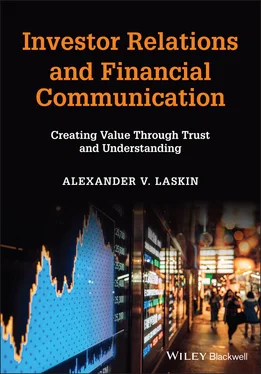World War I and the Great Depression slowed down the development of financial markets as well as investor relations and financial communications. However, the most important federal regulations appeared at that time, in large part in response to the stock market crash of 1929 – the Securities Act of 1933 and the Securities Exchange Act of 1934. These laws paved the way for professionalization of investor relations and continue to influence the practice of financial communications today.
The history of the professional period of investor relations and financial communication begins after the end of the World War II. The professional period saw the creation of professional associations, the appearance of the titles of investor relations officers, vice-presidents, and specialists, the arrival of big and small financial communication agencies, and the advent of stand-alone corporate investor relations departments. This period can be divided into three historical eras: the communication era , when investor relations and the financial communication landscape were dominated by people with communication backgrounds; the financial era , when the pendulum swung the other way and the field became dominated by professionals with financial and accounting degrees; and, finally, the current era, the synergy era , where the industry is looking for the balance between communication and financial fields of expertise.
The communication era of investor relations was characterized by the domination of strategic communication, public relations, marketing, and other communication professionals in performing the duties of IROs. Thus, this era is labeled the communication era.
The earliest mention of the investor relations function is traced back to Ralph Cordiner, a chairman of General Electric, who in 1953 created a department in charge of all shareholder communications. The first consulting agencies also began offering investor relations services. Most of the investor relations work focused on putting the word about organizations out and on attracting attention to the stock – perhaps not that different from the exploits of P. T. Barnum. Silver (2004) recalls that in its early years, investor relations was often associated “with the so-called dog and pony shows for sell-side analysts and retail investors, usually held at the offices of securities brokerages” (p. 70).
These developments were a response to the post-World War II economic boom that generated wealth for private Americans and at the same time encouraged business growth in order to satisfy the constantly growing needs of consumers. The corporations needed money to grow and develop; people needed a way to invest surplus income. In this situation, the meeting of the two worlds was inevitable.
Among the first corporations to strategically target private shareholders–consumers were car companies, such as Ford, GM, and Chrysler. It was no surprise that car companies figured out that if you give at least one share to a person who buys a car that person would never buy a competitor’s vehicle from that point on, and vice versa! Product marketing, as a result, merged with stock marketing. Increasing the demand for stock became an important part of the corporate agenda: “Occupants of the executive suites were quick to see, that all of this demand for stock was helping to push prices up and up. This helped immensely to finance growth, enhance empires” (Morrill, 1995). The companies accustomed to competing on the product market brought similar tactics to their competition on the financial markets. Thus, the investor relations function was charged with the task of grabbing investors’ attention and selling them the company in fierce competition with other corporations.
This was, however, a new experience for many corporations, a competition they were not prepared for. And, thus, most corporations looked outside for help. Unfortunately for them, investor relations agencies did not exist yet. In this vacuum of investor relations expertise, someone had to fill the void. Morrill (2007) explains that in this situation management turned to the recognized experts in communication – public relations and marketing: investor relations was often viewed as an extension of the public relations function.
In the 1950s, however, public relations was not a well-established practice itself. Only the largest companies had internal public relations staff and the functions and roles of public relations were quite limited. Cutlip (1994) suggests that in the first half of the twentieth century many viewed public relations as a simple adjunct to advertising to stimulate better sales. In addition, the end of World War II and the booming economy left little time for public relations, which was sliding to the bottom of the priority list. In fact, “many companies were undergoing radical change, often in the form of mergers and acquisitions, with new businesses and new executive personnel appearing on the scene. In these fluid situations, public relations often fell to the person nearest at hand” (Morrill, 1995). In other words, when corporations turned to public relations to manage investor relations, public relations was not yet ready to take on this challenge.
As a result, the new and not-well-established public relations function was suddenly charged with the additional duties of the investor relations job – a job for which most practitioners on the corporate or agency sides were not qualified. So, they approached this new task in the same way they approached other public relations tasks – relying on press agentry and publicity:
In concrete terms, shareholder relations became transformed into publicity, promotion and pageants… The annual reports suddenly blossomed as a 48-page, glossy sales brochure for the company’s products. The financial were there, mandatorily, but the sell was in the sizzle, not the steak… The annual meeting became a huge, gala free-for-all. A large eastern railroad put together a special train for stockholders and carried them first class to a company-owned hotel in the southern Appalachians for the meeting… An international telecommunications company held a large gathering under two large tents in central New Jersey. A bountiful lunch was served, and there were several open bars. Members of the press were delivered in limousines from New York and returned the same way. Products were richly displayed. The chairman, himself a noted gourmet and bon vivant, addressed the gathering. Reactions were enthusiastic – but absolutely nothing of substance was done… Companies made gifts or gift boxes of products available to shareholders, sometimes free. Liquor companies also provided their products under advantageous purchase agreements… The way companies treated their shareholders resembled more entertaining a blind date [rather] than developing a relationship.
(Morrill, 1995)
In addition, public relations practitioners who suddenly found themselves in charge of investor relations often “had little or no understanding of finance or of financial markets” (Morrill, 1995); they did not understand how the markets work and who the players are. The public relations practitioners were not ready to manage investor relations:
Punctilious attention to financial details was not one of their strong units. The story was. They were skilled in using the media, and the brokerage community, to propagate stories about their clients best calculated to arouse investor attention. Often they did not really understand more than the bare rudiments of what they were trying to sell… The trend to producing, peddling and promoting half-truths and untruths, even if cloaked in hedged language, was increasing at an accelerating rate – a sort of monkey see, monkey do syndrome.
Читать дальше











